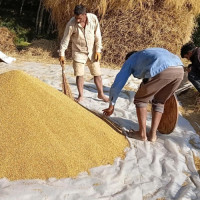- Monday, 22 December 2025
Water Tourism Booms Along Sukute Corridor
Located on the bank of the Sunkoshi River in Sindhupalchowk district, the Sukute Corridor has emerged as a major tourist attraction, with water tourism activities like rafting and river meditation gaining popularity. The area has witnessed rapid growth in the number of lodges in recent years. Along this corridor, there are about 30 lodges in operation. Of them, around one and a half dozen are big ones. The lodges are now capable of providing accommodation facilities to as many as 5,500 guests per night. These facilities have employed more than 1,100 people, mostly locals.
Before the outbreak of COVID-19, foreign tourists used to account for nearly 90 per cent of the total guests visiting the area. The trend has now been complete, with almost 99 per cent of visitors being Nepalis. Visitors can experience rafting, riverside camping, and musical programmes during their stay. With a surge in the number of Nepali adventurers, bar sales have been increasing considerably. The area is free from administrative hassles as well.
High rapids
The Upper Bhotekoshi River ranks seventh in the world in terms of rafting because of its high rapids. Most foreign adventurers appear to be interested in experiencing rafting in the area between Nayapul and Bunjee jumping sites in Tatopani. This area sprawls over 21 kilometres. It takes about four hours for rafting teams to cover this distance. As this section is very challenging technically, rafting companies organise trips only after making demonstrations and giving necessary briefings to participants to prevent accidents.
The normal section ranges from Khadichaur to Dolalghat. This area covers 18 kilometres. Its full course can be completed in three hours. The lower section of the Sunkoshi River offers a 10-day trip up to Chatara in Sunsari district. This section starts at the Sukute Corridor and ends at Chatara. Water adventurers from across the world enjoy riverside camping along with the sound of the river. In the past, only foreigners used to take part in this adventure activity. Now even Nepalis have begun showing their interest in it.
The Sukute Corridor has a lot of adventure events to offer. As a new attraction, paragliding takes off from Lamachaur, while its landing point is located near Sukute Bazaar. Cliff jumping is also available there. Adventure seekers jump from a cliff into the river. Water adventurers can also experience cannoning. The Chhatekhola above Sukute is famous for cannoning.
Looking at a variety of such activities, the Sukute Corridor is now becoming popular as a hub for water sports. Given boundless prospects for water sports tourism, a rafting school has now been under construction in Balephi Rural Municipality-5. Once this institute comes into operation, it will produce the required human resources for water sports tourism, which has great scope. This is the first institute of its kind in Asia and the third one in the world. The school is known as the Nepal Whitewater Centre. Besides, it will also help promote water sports and support the industry. The government has made available Rs. 130 million for its development. This is the brainchild of a French adventurer who was here in Nepal in 2018 to participate in the International Whitewater Challenge Competition. He took us into confidence in such a manner that we were inspired to work towards materialising this.
As we have enormous potential for water tourism, we need to conduct research on this sector and hold competitions time and again for the promotion of water sports.
It is a matter of pride for us that Nepali river guides are in high demand internationally. Numerous international companies hire them without the involvement of any agents. Japan alone hires around 500 Nepali river guides annually. Numerous European, American, and other countries employ a lot of such technical human resources every year. The number of female river guides in Nepal has also been on the rise. In 2022, a total of 54 women received licences after having trained. After providing river guide training, the Nepal Association of Rafting Agents (NARA) recommends the Nepal Academy of Tourism and Hotel Management (NATHM) issue licences to the trained persons. NATHM conducts practical tests before issuing licences to them. In Nepal, 100-plus river guides are produced every year. But most of these skilled human resources go abroad in search of better job opportunities.
The White-Water Centre is planning to start conducting river guide training in December. The task of preparing operations guidelines for the training has reached its final stage. As per the guidelines, the institute will be in operation with the joint effort of NARA, NATHM, the local government, and the Sindhu Tourism Business Association.
The institute will generate a lot of revenue as more youths are keenly interested in river guide training. Nepal is also regarded as the best place for kayaking because of the running water. The institute will run short-term courses on varied forms of water tourism. Some months ago, the first Nepal-China Friendship Dragon Boat Race Festival was held on the Fewa Lake in Pokhara. Organised by the Nepal Tourism Board in collaboration with the Chinese Embassy in Kathmandu and the Pokhara Metropolitan City, the two-day event aimed at enhancing cultural relations between the two countries and attracting more Chinese tourists to the country. Another objective of the event was to help promote Pokhara International Airport. Altogether, 120 participants from the two nations competed in eight boat races. Nepali participants also showed excellent performances in the event.
Though rafting has been included in the Asian Games, the Nepal Sports Council has not recognised this sporting activity. NARA has been lobbying to make rafting a part of the Asian Games. However, NATHM has recognised rafting as an important tourism-related activity in Nepal. It has nominated NARA as an invitee member of its board.
Karnali Quest in offing
In November this year, the Karnali Quest is going to be organised. This will be the largest-ever rafting competition in the world. Water adventurers will have the opportunity to experience 248 km of rafting on the Karnali River. Participants from many countries around the world are taking part in this weeklong event. We hope that this event, which is going to be included in the Guinness Book of World Records, will be vital for promoting Nepal’s river tourism.
Despite having enormous potential for rafting in Nepal, no significant effort has so far been made by the government. It is the responsibility of the government to develop start points and other infrastructure for rafting. Another obstacle to the development of rafting is haphazard river excavation. If such activities continue, the country will not only lose rafting as a tourist attraction but will also face a big environmental problem in no time. The government has fixed 16 rivers for rafting. However, the increasing trend of constructing hydropower plants has posed a serious threat to these rivers as well. The time has come for the government to come up with a stable policy on the conservation of rivers.
(The author is a tourism entrepreneur.)
















